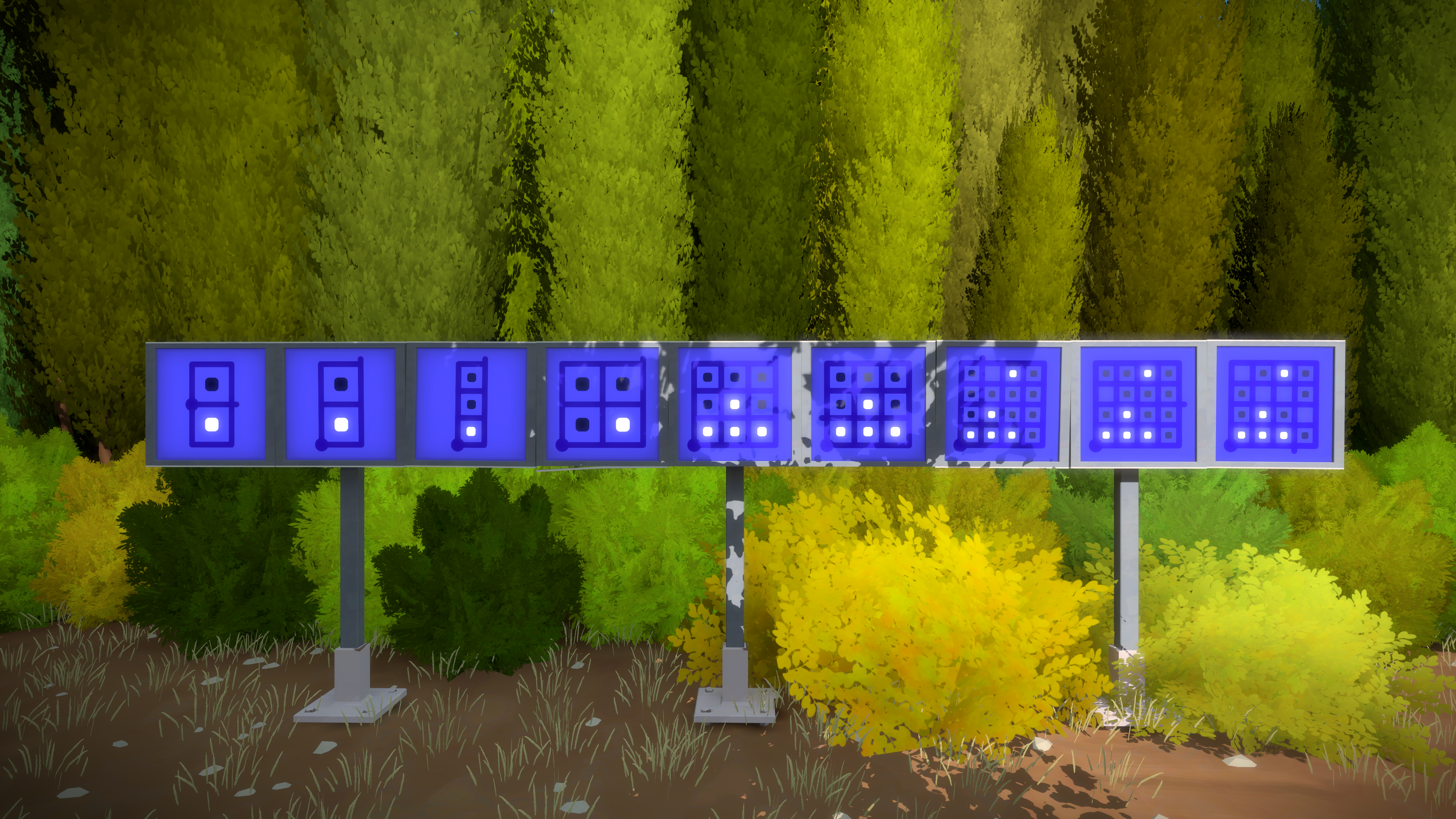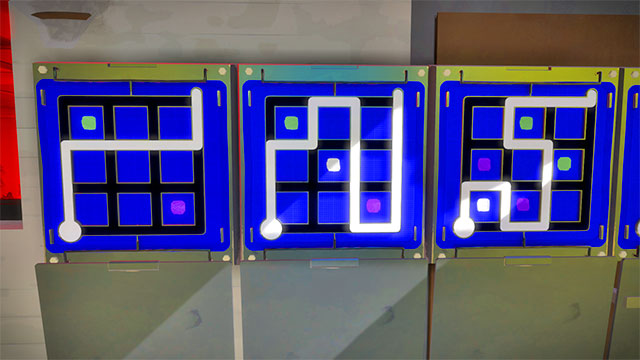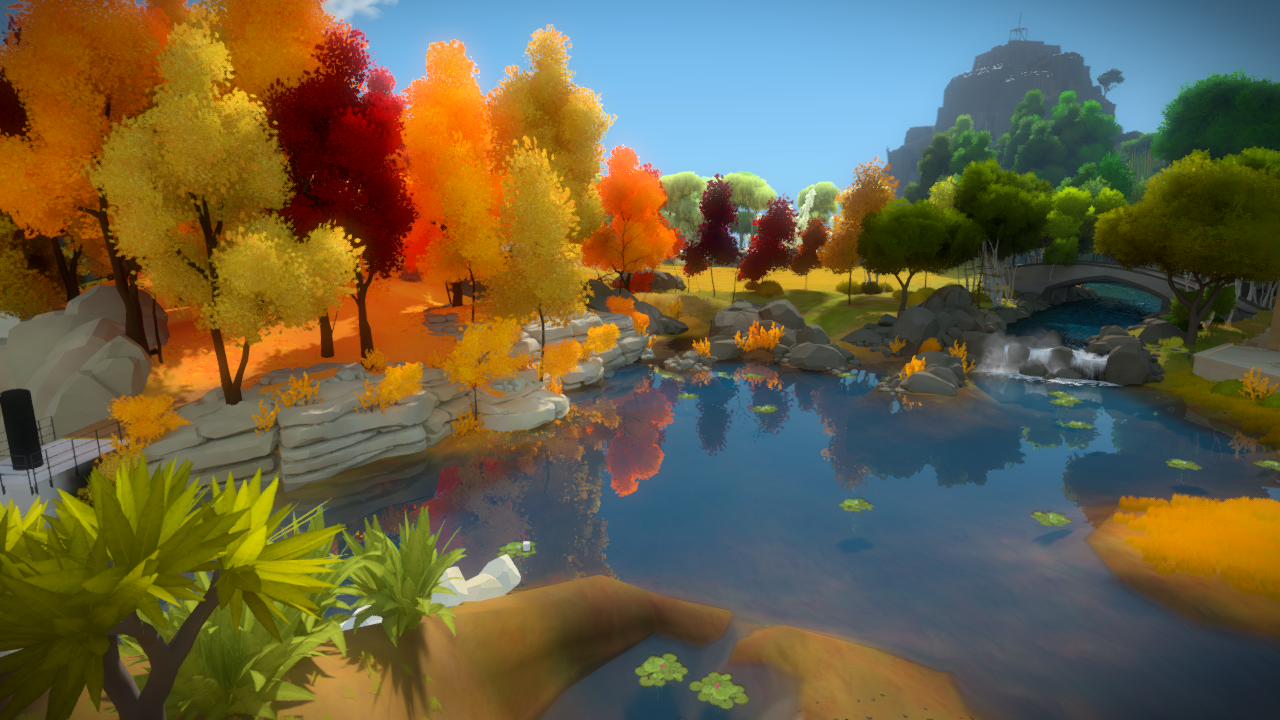Short Version: I don’t believe in such as thing as a perfect game, but The Witness comes dangerously close to being one. If you like puzzle games in any way then I highly, HIGHLY recommend you play this. If you are not a fan of puzzles, lack of fast-paced action or just using your brain in general, then I say you skip this game, because you won’t like it and definitely not understand it.
Puzzles as Communication
Long Version: As I think about The Witness and the utter obsession that has grown out of me playing it, I feel that if I don’t choose my words carefully, I might spoil a lot of what this wonderful game is about. I also apologize in advance if my review ends up feeling a bit all over the place. There is seriously so much to talk about that it’s difficult to figure out what to cover first. Knowing this, I guess there is no better way to start than by giving the bare essentials.
Seen by many as a “modern-day Myst,” The Witness is a game developed mostly by Jonathan Blow after finishing his previous game Braid. With the help of an incredibly talented team, they were able to create a game that surpasses Blow’s previous work by a large margin, while staying within his recognizable traits of subtlety, mind-crushing puzzles and so many underlying layers to discover that even onions would start expressing jealousy.

Deep Thinking Begins Again
You begin the game as a nameless, faceless, voiceless person that explores an island full to the brim with maze-like line puzzles, where the goal is to get from one side of the maze to the other. The puzzles, just a much as the island, sound relatively simple, but don’t let what you see on the surface deceive you; It gets, much, much deeper than that. Both the island and the puzzles have what seem to be a symbiotic relationship throughout the entire game, so it is not possible to simply have a game featuring only the puzzles by themselves and sell that for cheap on the iOS App Store, like most people have erroneously pointed out.
There are many moments in the game that involve puzzles where you will be forced to check your surroundings, listen to the environments or even leave the current area and keep exploring the island until you bump into an easier puzzle that will teach you a mechanic that will help you solve the one you weren’t able to get through in the first place. Many of the puzzles will actually have a physical effect on the island, almost as if the puzzles themselves were a form of communication. Many of these will also have multiple solutions in order to serve different functions within the island, like switches, elevators and even modes of transportation. All of these results are further punctuated by the game’s lack of music, making your effect on the island all the more noticeable through sound and a masterful grip on color, which fills these environments with life despite how empty it is in regards to life forms inhabiting the island.
That’s the brilliance of the game. After completing what is essentially the initial tutorial area, the doors to the rest of the island open wide, giving you access to 11 very colorful areas in the island to which then you are able to explore in whatever order you want, similar to the original Legend of Zelda. All the areas come with their own sets of puzzles and different ways to solve them. All the puzzles will range from simple and straight forward to the “I’ve been staring at the screen for hours on the same puzzle, but when I woke up the next morning I did it in like 2 minutes WHAT THE HELL I’M SO STUPID AAAAAAAAHHHHHH” kind of difficult.

So Hard, but so Good
There were many moments where I found very simple sets of panels that taught you a certain mechanic, but then it proceeded to immediately turn those concepts around on their heads (sometimes literally), which usually ended up with me carrying over more than 50 pictures of line puzzles on my phone as I manipulate and edit them to further understand what I was suppose to do, which sounds like a hassle, but it actually felt like part of the fun. All the puzzles are logic-based, so it’s not like it’s the game’s fault that I struggled through most of it. The solution is always in front of you, and not solving these puzzles come out of simply missing something or getting too caught up on trying to solve the puzzle a certain way that one fails to look at things from a different perspective. It’s pretty symbolic of life If I do say so myself.
That is yet another moment of brilliance in The Witness: You get whatever it is you are willing to put in. Depending on how much you are willing to see, you’ll probably never know that you need to complete 7 areas of the island before being able to beat the game. You’ll probably never know about all the shortcuts you can use on the island to travel. You’ll probably never know that there are audio logs all over the island with messages that initially can come off as a bit preachy or pretentious, but finding all of them will make everything start to come together and make sense. In other words, this game is dripping with secrets. Do not take anything for granted in this game. Anything.

The Best Kind of Loneliness
I hate to be vague about the finer details in the game, but that would mean spoiling a lot of it and ruining the things that made it incredibly fun for me when I first played it not knowing anything. Overall, it is a beautiful journey into exploration; mental bodybuilding and even some philosophical thinking that make up The Witness. Even as I write this review, all I can think about is those line puzzles and which ones I’m going to solve when I inevitably pick up the game again and start wracking my brain in trying to discover all the secrets, peel off all the layers and learn as much as I can about this mysteriously lonely and fascinating island with a purpose.
Other than wanting to be able to walk off ledges or even be able to jump, I wouldn’t want to change anything about The Witness. I love pretty much everything about it with only a microscopic amount of criticism over the controls. This along with games like Undertale truly demonstrate the things that only video games are capable of doing.

Go play The Witness.










Game Review – The Witness (PS4)
1Short Version: I don’t believe in such as thing as a perfect game, but The Witness comes dangerously close to being one. If you like puzzle games in any way then I highly, HIGHLY recommend you play this. If you are not a fan of puzzles, lack of fast-paced action or just using your brain in general, then I say you skip this game, because you won’t like it and definitely not understand it.
Puzzles as Communication
Long Version: As I think about The Witness and the utter obsession that has grown out of me playing it, I feel that if I don’t choose my words carefully, I might spoil a lot of what this wonderful game is about. I also apologize in advance if my review ends up feeling a bit all over the place. There is seriously so much to talk about that it’s difficult to figure out what to cover first. Knowing this, I guess there is no better way to start than by giving the bare essentials.
Seen by many as a “modern-day Myst,” The Witness is a game developed mostly by Jonathan Blow after finishing his previous game Braid. With the help of an incredibly talented team, they were able to create a game that surpasses Blow’s previous work by a large margin, while staying within his recognizable traits of subtlety, mind-crushing puzzles and so many underlying layers to discover that even onions would start expressing jealousy.
Deep Thinking Begins Again
You begin the game as a nameless, faceless, voiceless person that explores an island full to the brim with maze-like line puzzles, where the goal is to get from one side of the maze to the other. The puzzles, just a much as the island, sound relatively simple, but don’t let what you see on the surface deceive you; It gets, much, much deeper than that. Both the island and the puzzles have what seem to be a symbiotic relationship throughout the entire game, so it is not possible to simply have a game featuring only the puzzles by themselves and sell that for cheap on the iOS App Store, like most people have erroneously pointed out.
There are many moments in the game that involve puzzles where you will be forced to check your surroundings, listen to the environments or even leave the current area and keep exploring the island until you bump into an easier puzzle that will teach you a mechanic that will help you solve the one you weren’t able to get through in the first place. Many of the puzzles will actually have a physical effect on the island, almost as if the puzzles themselves were a form of communication. Many of these will also have multiple solutions in order to serve different functions within the island, like switches, elevators and even modes of transportation. All of these results are further punctuated by the game’s lack of music, making your effect on the island all the more noticeable through sound and a masterful grip on color, which fills these environments with life despite how empty it is in regards to life forms inhabiting the island.
That’s the brilliance of the game. After completing what is essentially the initial tutorial area, the doors to the rest of the island open wide, giving you access to 11 very colorful areas in the island to which then you are able to explore in whatever order you want, similar to the original Legend of Zelda. All the areas come with their own sets of puzzles and different ways to solve them. All the puzzles will range from simple and straight forward to the “I’ve been staring at the screen for hours on the same puzzle, but when I woke up the next morning I did it in like 2 minutes WHAT THE HELL I’M SO STUPID AAAAAAAAHHHHHH” kind of difficult.
So Hard, but so Good
There were many moments where I found very simple sets of panels that taught you a certain mechanic, but then it proceeded to immediately turn those concepts around on their heads (sometimes literally), which usually ended up with me carrying over more than 50 pictures of line puzzles on my phone as I manipulate and edit them to further understand what I was suppose to do, which sounds like a hassle, but it actually felt like part of the fun. All the puzzles are logic-based, so it’s not like it’s the game’s fault that I struggled through most of it. The solution is always in front of you, and not solving these puzzles come out of simply missing something or getting too caught up on trying to solve the puzzle a certain way that one fails to look at things from a different perspective. It’s pretty symbolic of life If I do say so myself.
That is yet another moment of brilliance in The Witness: You get whatever it is you are willing to put in. Depending on how much you are willing to see, you’ll probably never know that you need to complete 7 areas of the island before being able to beat the game. You’ll probably never know about all the shortcuts you can use on the island to travel. You’ll probably never know that there are audio logs all over the island with messages that initially can come off as a bit preachy or pretentious, but finding all of them will make everything start to come together and make sense. In other words, this game is dripping with secrets. Do not take anything for granted in this game. Anything.
The Best Kind of Loneliness
I hate to be vague about the finer details in the game, but that would mean spoiling a lot of it and ruining the things that made it incredibly fun for me when I first played it not knowing anything. Overall, it is a beautiful journey into exploration; mental bodybuilding and even some philosophical thinking that make up The Witness. Even as I write this review, all I can think about is those line puzzles and which ones I’m going to solve when I inevitably pick up the game again and start wracking my brain in trying to discover all the secrets, peel off all the layers and learn as much as I can about this mysteriously lonely and fascinating island with a purpose.
Other than wanting to be able to walk off ledges or even be able to jump, I wouldn’t want to change anything about The Witness. I love pretty much everything about it with only a microscopic amount of criticism over the controls. This along with games like Undertale truly demonstrate the things that only video games are capable of doing.
Go play The Witness.
Game Review – MegaTagmension Blanc + Neptune Vs. Zombies (PS Vita)
Game Review – Overfall (Steam Early Access)